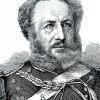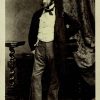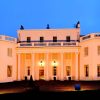Lieutenant Colonel George Palmer Jnr has been immortalised in Palmer Place, North Adelaide as a member of the South Australian Colonization Commission whose members were each given street names on the plan surveyed by Colonel William Light and his assistants in 1837.
It should be noted that the name finally gazetted for Palmer Place was not that of George Palmer Snr MP as put forward by Colonel Robert Torrens, but that of his son, Lieutenant Colonel George Palmer. This appointment was irregular to say the least. When it became known that new names were going forward, George Palmer Snr got wind of the potential for an appointment and began to ingratiate himself with Torrens, who was then acting pro temporeas the putative Chairman of the foreshadowed Commission. He wrote to Torrens and Robert Gouger offering his services, but at the same time he rather cleverly sought patronage for his son, Lieutenant Colonel George Palmer Jnr.
Palmer Snr was closer to his mid-60s and his son only in his mid-30s, an age hardly commensurate with the gravitas required of an experienced commissioner. This action by Palmer Snr can be construed as nepotism and with impeccable timing. Given that the Duke of Wellington was briefly back in power, George Palmer Jnr was duly appointed with the Duke’s blessing. This made Lieutenant Colonel George Palmer one of the few conservatives appointed in any capacity at the Adelphi.
Lieutenant Colonel George Palmer Jnr came from a long line of Palmers, who maintained a family seat at Nazeing Park, in Essex, for more than 200 years. The estate passed to William Palmer (1748–1821), who was Lieutenant Colonel George Palmer Jnr’s grandfather, before passing to his father, George Palmer Snr in 1821. They all descended from an old Leicestershire family in Wanlip.
George Palmer Snr joined the navy of the East India Company between 1786 and the end of the eighteenth century. He married Anna Maria Bund of Wick, Worcestershire, in 1795. They had three sons: our subject, Lieutenant Colonel George Palmer; his next brother, William Gresham Palmer, a Professor at Law; and Francis, also a barrister. Of their two daughters, Anna Maria died prematurely and Elizabeth married Robert Biddulph MP in 1830.
Palmer Snr had an eventful career in the East India Company, during which time he became a close friend of Captain Francis Light, Colonel William Light’s father who is known in Georgetown as the ‘Father of Penang’. Francis joined with George Palmer Snr and his brother Horsely in business to become East India merchants and ship owners operating between London and Georgetown. Malaysians in Georgetown today still revere the name of Light. Over several decades the family owned or commissioned many ships including a number of East Indiamen.
During this period there was considerable diversification of the wider family enterprises, especially in Bengal and Calcutta. Unfortunately, the economic uncertainties of the mid-1820s and over-speculation in indigo on the London Stock Exchange led to a devastating bankruptcy of all the Palmer conglomerates. Many business houses crashed along with the Palmers and debts were said to be well over £400,000. George Palmer Snr thereafter began to take a closer interest in shipping and shipping safety around about the time he was seeking to enter parliament. In 1831 he combined with other ship owners to initiate the General London Shipowners Society and as its Chairman sought to formalise the registration of shipping. This is from where the Lloyd’s Shipping Register evolved.
Palmer Snr also sought to standardise the way in which shipping capacity was measured, prompting the Admiralty to lobby for what became known as the Tonnage and Measuring Act of 1835. One other lasting contribution of George Palmer Snr was the Royal National Lifeboat Institution. His lifeboat designs became standard for both merchant and naval shipping worldwide.
George Palmer Jnr was the eldest son of Palmer Snr and Anna, born four years into their marriage in 1799. He was raised in privileged circumstances in the family home at Nazeing Park before being sent to Harrow for three terms as part of his formal education. He was a young man when he joined Palmer Mackillop & Co., where he no doubt gained valuable experience associated with fitting out and victualling large ships, some of them East Indiamen of more than 1,000 tons.
In 1827 he married a close relative of Lord Eldon in Miss Elizabeth Charlotte Surtees, the second daughter of the late Mr John Surtees of Newcastle upon Tyne, in the county of Northumberland.
In the mid-nineteenth century, Lieutenant Colonel Palmer Jnr served with distinction in the Bengal Civil Service and in defence of the Indian Mutiny of 1857. He received both a medal and clasp and special thanks from Queen Victoria. He was also a Justice of the Peace in Essex, like his father, and a Knight of Justice of the Knights Hospitallers of the Sovereign Order of St John of Jerusalem.
By the time George Jnr’s name was gazetted in May 1835, Lord Melbourne was again Prime Minister, having accepted King William IV’s offer to form a government; Wellington being unable to do so. Melbourne probably endorsed Palmer Jnr’s appointment by Wellington because during the Swing Riots of 1830 when he was Home Secretary, Melbourne took a hard line on the rioters, enjoying the support of conservatives and agricultural landholders, like the Palmers, in putting them down.
Drawing on his experience with the London and Westminster Light Horse Volunteers in which he had enlisted in 1819, Colonel Palmer Jnr greatly assisted the effort to put down rioting by raising the Essex Yeomanry Cavalry to protect government establishments at Waltham Abbey and Enfield Lock. He subsequently took his seat on the South Australian Commission, joining Montefiore as one of the two youngest commissioners. This in part explains their energetic and competent approach to the procurement of the necessary shipping and stores for the Commission. Both were honorary appointments.
George Palmer Jnr’s youthfulness may also account for some of the ill feeling which arose between him and the more radical but equally young volunteers at the Adelphi, like John Brown and George Strickland Kingston. Taking a position of pompous superiority, Palmer had little time for Rowland Hill and there are several pejorative references to Palmer in Brown’s diary to suggest that he was not popular with the ideologues. Nevertheless, Palmer was considered to be competent when it came to fitting out and preparing the Commissioner’s ships for the long voyage south.
After Light died, Palmer and Montefiore in a tribute to the Surveyor General went to Raikes Currie suggesting that he hold monies to be collected at his family bank with the intention of memorialising Light in some way. In all, £36 was collected and set aside, awaiting an inscription on a suitable silver cup or bowl before it was to be sent out to Adelaide. The idea was for the Corporation of the City of Adelaide to hold it in perpetuity and drink from it each year in tribute to the Surveyor General.
A case can be made that because of Lieutenant Colonel George Palmer Jnr’s adulation of Colonel Light, much of the euphoria and admiration which surrounds Light today stems from the recognition Palmer lavished on him and his achievements throughout their long association. Light was thirteen years older than Palmer, so it is conceivable that Palmer knew him when he was a small child and looked up to him as the quintessential soldier. Furthermore, they had things in common – an association with the military, an interest in shipping, and they were both competent horsemen. In a sense, it was Palmer who, years after Light had passed away, kept the flame alive. That is not to devalue Light’s accomplishment as Surveyor General in any way, but Palmer more than anyone kept Light before the public.
In the 1850s Palmer began to take a closer interest in matters Australian, especially after his father died in 1853. It is as though he viewed his time on the Commission in the 1830s as one of the highlights of his life and he continued to revisit things Australian thereafter. The punch bowl arrived in Adelaide in 1859 and at about the same time he became a director of the Australian Mining Company which began exploration on the eastern side of the Mount Lofty Ranges within fifty kilometres (32 miles) of Adelaide. The small township which grew in response to the mine was called Palmer, in his name.
When the Overland Telegraph line between Adelaide and Darwin was finally completed in August 1872 it drew worldwide attention. Colonel Palmer Jnr could not resist going public to explain how he was involved as one of the South Australian commissioners, some 36 years earlier..
When George Palmer Snr MP died in 1853, Lieutenant Colonel George, as the eldest son, inherited Nazeing Park. He immediately took a strong hand in the management of the estate and soon gained notoriety as a person of significance in the county. As a result, he was appointed Magistrate for Essex and in 1863 was promoted to High Sheriff.
Significantly, Colonel George Palmer Jnr was also verderer for Epping Forest, one of the royal forests protected for both hunting and carefully harvested oak forestry. Verderers were essentially judicial officers whose job it was to protect the forests and the wild game, including venison, from unauthorised encroachment and agricultural abuse. During the latter part of the eighteenth century deer hunting by Royal Households was losing its popularity and by 1850 George Palmer was the only remaining verderer in Epping Forest. Previously there had always been four who all swore an oath of allegiance to the monarch and who were under obligation to ‘execute the laws of the forest and to do equal right and justice as well to the poor as to the rich’. This explains much about Palmer, particularly his obsequious deference to royalty, his religious attachment to authority and his strong sense of justice towards those less fortunate who came across his path.
Colonel George Palmer Jnr and his wife Elizabeth Charlotte had three sons and a daughter who survived to adulthood. Two other children – a boy, William Cotterell Surtees Palmer, died as an infant of nine months on 8 May 1842, and unfortunately a daughter also passed but a few days after the Colonel’s wife Elizabeth died giving birth to her on Sunday 30 July 1848. These losses must have been extremely difficult to bear and were only exacerbated when Palmer’s father passed away soon afterwards in 1853.
Lieutenant Colonel George Palmer Jnr died peacefully on 26 April 1883. He was in his 85th year and his remains are enshrined in All Saints Church at Nazeing.







Comments